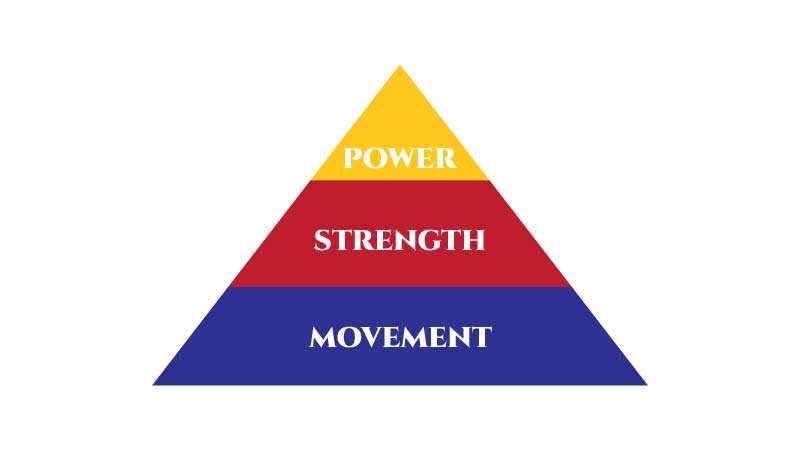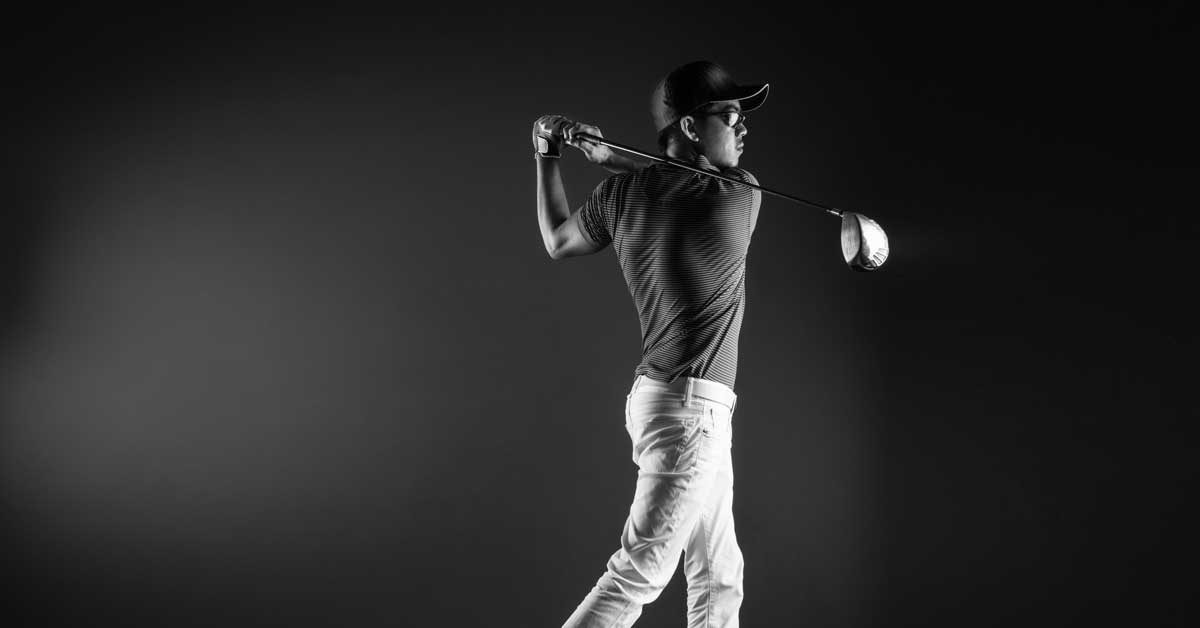Who doesn’t love a nice round of golf on a beautiful Saturday? Drinking some beers, getting some sunshine, catching up with good friends—for years, this has been the image many people had in their mind when thinking of the game of golf. But when golf is your livelihood, the game looks a bit different. At the elite level, it is a sport requiring a true sense of athleticism, strength, and power.
In the world of training, the term “sports specialization” is thrown around a lot, and—granted—the only way to truly specialize in a sport is to play the sport. Golf is no different, and due to the intricacies of the swing, it becomes extremely important that the strength professional not only understands their golfers’ physical needs, but also the basic tenets of the golf swing, and how those physical improvements will correlate to a more efficient swing.
Improved club head speed—which then transfers to ball speed—can mean a huge difference in driving distance. And while many think that 10-20 yards of driving distance isn’t all that much, that difference can be worth millions; or, for some pros, the difference between having a year of status on the PGA or LPGA Tour or battling their way to the top on the Korn Ferry and Symetra Tour (or on the numerous other mini tours that exist).
Why Biomechanically Specific Strength and Power Are Vital to a Golfer’s Success
A golfer’s body must be able to move through the range of motion required of the swing, all while producing force and maintaining balance and stability—but not rotating through the spine; rather, through the torso. Oh, and there’s the whole upper body/lower body disconnect and keeping the kinematic sequence of the swing in proper order. If it sounds like a lot…it is. So, producing force and power along with maintaining and building strength play key roles in the success of a golfer.
Producing force and power along with maintaining and building strength play key roles in the success of a golfer, says @J_Golden85. Share on XIn a normal golf swing, a player will typically maximally recruit 30 lbs. of muscle to generate four horsepower throughout the swing. This equates to around 900 kgs of force being applied to the ball in half a millisecond at impact, an action that is repeated multiple times in a round of golf. On a par-72 course, if a pro ends up shooting even par, on average they will take 36 full swings. This number doesn’t take into account players going for the green in 2 on a par-5. Currently, the average driving distance on the PGA Tour is 297 yards, with Cameron Champ averaging a whopping 322 yards.
All of this poses a question—what does a training program entail for an elite-level golfer? Obviously, training is so individualized in the sport that it’s going to look different for every player, but for the sake of this article, let’s focus on young, up-and-coming PGA and LPGA Tour players who are currently looking to build power and gain more club head speed and discuss the needs of that particular athlete.
1. Movement
A movement assessment is important for any athlete, not just a golfer. One philosophy I have carried with me through my years as a coach is my movement pyramid. At the foundation of the pyramid is movement, followed by strength, with the top of the pyramid being power. In other words, if you can’t move properly, nothing else will follow. You can’t have strength without movement, and you can’t have power without strength. If you’re lacking in any of those areas, the pyramid’s foundation will ultimately become weak and unstable.

The Titleist Performance Institute (TPI) talks about assessing each golfer before beginning a training program. “Assess, don’t guess” is the expression they use, and they have put together an entire certification based on assessing a golfer’s physical capabilities, covering the entire body. It is a screen that gives strength and conditioning professionals, as well as golf coaches and medical professionals, the chance to work together to come up with a plan to help improve a player’s swing. It allows the strength professional to see not only an imbalance in a player, but also where a player is moving well, and then build on that player’s strengths.
2. Strength
A very important aspect in developing club head speed is vertical jump power. There is a direct correlation between increased club head speed with a driver and vertical jump height. But, much like the pyramid shows, you can’t begin to think about developing power until you have the strength necessary to create the power. Remember how they say in order to create a bigger vertical jump, work on your squat? This is exactly the reason why it’s such a widespread belief—because improving your squat means you’re building strength, which will then translate into power.
Now, I’m not saying all golfers have to back squat to improve leg strength, but they do need to do heavier, compound movements during certain phases of their training. But strength is relative, and when you’re looking at all types of different people with different physical capabilities, exercise selection becomes that much more vital. It is our job as performance professionals to find what works best for our athletes.
I’m not saying all golfers have to back squat to improve leg strength, but they do need to do heavier, compound movements during certain phases of their training, says @J_Golden85. Share on XWe can always teach someone to back squat and get them into a perfect squat over time. In a perfect world, we all have time for that. But sports, especially golf, don’t reside in a perfect world, and we only have a limited amount of time to get a player ready for the grind of a long season. It is our job to do what is best for the person we are working with, and many times, the back squat may not be the best tool to utilize (but that’s a discussion for another day).
Even though everyone is different, and it’s important to be adaptable in your philosophy, it’s also important to stick to what you, as a performance coach, do best. For me, I believe in what I view as the five basic tenets of a good program: push, pull, squat, hinge, and carry.
Lower Body
When it comes to strength training, any type of squat variation is my go-to for heavy strength movements. A trap bar deadlift is another great option due to the fact that it is easy to teach, and the bang for the buck an athlete can get from it is so high.
RDLs and SL RDLs are two exercises that are a must in any training program for golfers. The need for a strong posterior chain in any sport cannot be understated, but in golf, where the glutes are one of the most—if not the most—important muscles in the body, it’s vital to make sure they are strong and activating properly.
In terms of unilateral lower body pushing movements, the DB split squat or rear-foot-elevated split squat are exercises widely used by golfers and ones that hit all the major muscle groups a golfer will utilize. A lateral lunge is another accessory exercise that is very beneficial to building strength in the lower body.
Activating—or getting the muscles firing—is widely discussed in the performance world. In other words, getting the muscles primed for performance. A series consisting of glute bridges with a mini-band around the athlete’s knees, clams, hip internal rotation, and bird dogs with the band on is a great way to begin their movement pattern work before lifting, and become a part of their pre-round warm-up.
Upper Body
As is the case in heavy rotational sports, the debate about whether to use the barbell bench press comes to the forefront of any discussion on training. Once again, this comes down to the athlete you’re training and what is best for them. Players need to understand their bodies and be able to communicate what will work well for them at the level they’re playing.
Brooks Koepka, the #2 ranked golfer in the world, benched 225 lbs. for reps before the third round of the Honda Classic last year. Other golfers wouldn’t touch a heavy, endurance-based bench press workout before starting their 36th hole of any tournament, let alone a Major. Once again, though, what works for one person doesn’t necessarily work for another, which is why the performance professional working with golfers needs to be adaptable in their philosophy.
So, About the Benching Myth…
If you choose not to include the barbell bench press in your program, there are many other ways to get the upper body pushing necessary to help achieve the results needed. Dumbbell training exercises, especially in upper body pushing motions, are a great way to gain strength while building stability and balance in the upper body. An alternating DB incline bench is an example of an exercise that is adaptable in many ways, while still providing the necessary resistance for an athlete to achieve the strength results that they are looking for.
What About the Posterior Chain?
There are so many options that, in my opinion, not one is wrong. Whether you’re talking about a vertical pull like a lat pulldown or pull-up, or a horizontal pull like a seated low row, anything will work. In terms of pulling, there is no bigger bang for your buck than pull-ups, but it is important to stick to the rule of thumb of 2:1 ratio of pulls to push.
3. Power
I’m not going to get into the debate over Olympic lifts in this article. There are so many ways to develop power without them, and many golfers entering the professional ranks, depending on what they’ve done while in college, may have limited experience with them. So, sticking to the basics and getting golf athletes in triple extension is the safest, most efficient way to build power.
Sticking to the basics and getting golf athletes in triple extension is the safest, most efficient way to build power, says @J_Golden85. Share on XIf you build them properly into the program, the benefits will carry over to the course.
- Trap Bar Jumps
- Box Jumps (landing focus)
- Skater Hops for distance
- Split-Squat Jumps
- MB Squat Jumps
- MB Slams and MB Rotational Wall Slams
These are just some of the exercises that you can utilize as power movements in the program.
Contrast Training
A fast way to build work capacity along with power is to implement contrast training. The athlete needs to have a foundation of strength, but contrast training—pairing a strength movement with a non-resisted or lightly resisted power movement—is a great way to create work capacity and get the body working and adapting to different physiological barriers.
Some very effective pairs in contrast training include DB split squats paired with skater hops and goblet squats paired with MB squat jumps or power step-ups without weight. These are just a few examples that show the benefits of what contrast training can do when programmed properly.
More Forceful Golfers
Lifting weights—once seen as dangerous to golfers—is quickly becoming a normal part of a golfer’s routine. Previously believed to make a golfer stiff and slow, weight training is now widely perceived as a necessary tool by many on Tour to improve their game.
Golf is a multi-faceted game with many different areas of need. With courses being lengthened and players hitting the ball further than ever, it has become very important for young golfers to be able to produce force off the tee. Strength and conditioning is a huge part of players being able to develop the necessary force while staying healthy through one of the most explosive, complex movements in any sport.





